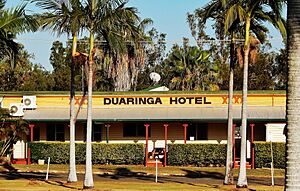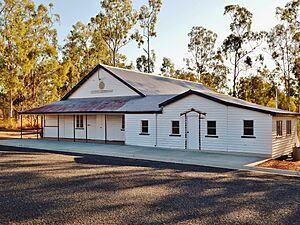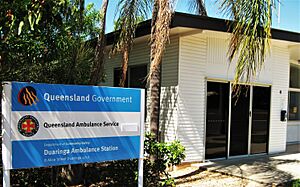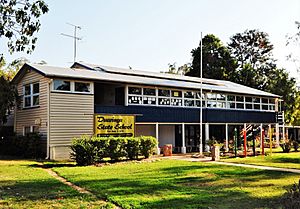Duaringa facts for kids
Quick facts for kids DuaringaQueensland |
|||||||||||||||
|---|---|---|---|---|---|---|---|---|---|---|---|---|---|---|---|
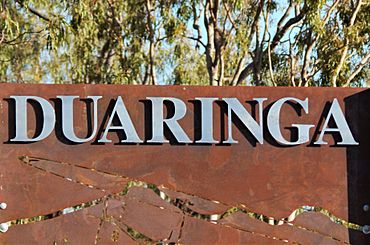
Duaringa sign on Capricorn Highway
|
|||||||||||||||
| Population | 262 (2021 census) | ||||||||||||||
| • Density | 0.3812/km2 (0.987/sq mi) | ||||||||||||||
| Postcode(s) | 4712 | ||||||||||||||
| Area | 687.3 km2 (265.4 sq mi) | ||||||||||||||
| Location |
|
||||||||||||||
| LGA(s) |
|
||||||||||||||
| Region | Central Queensland | ||||||||||||||
| State electorate(s) | Gregory | ||||||||||||||
| Federal Division(s) | Flynn | ||||||||||||||
|
|||||||||||||||
Duaringa is a small town in Central Queensland, Australia. It is a rural area in the Central Highlands Region. Part of the town is also in the Aboriginal Shire of Woorabinda. In 2021, Duaringa had a population of 262 people.
Contents
Geography
Duaringa is located on the Capricorn Highway. It is about 116 kilometres (72 miles) west of Rockhampton. The Dawson River forms the eastern edge of the area. The Mackenzie River is on the northern side.
The Mackenzie River crossing is about 20 kilometres (12 miles) north of Duaringa. This gravel road can lead to Marlborough, Queensland. However, the river crossing can close quickly when there is heavy rain.
The Dawson River provides water for Duaringa. It flows east of the town. The Capricorn Highway crosses the Dawson River about 12 kilometres (7.5 miles) east of Duaringa. The bridges are high, so only major floods close the highway.
The Dawson River and the Mackenzie River join together north-east of Duaringa. They form the Fitzroy River. This river flows through Rockhampton. A painting on the Duaringa Historical & Tourism Information Centre shows these three rivers.
What's in a Name?
The name "Duaringa" has a few possible origins. No one is 100% sure how it started.
One idea is that it comes from an Aboriginal word, "djuaringe." This word might have been used by Aboriginal people from the Wakawaka or Barunggam languages. It is thought to mean "to turn oneself around."
The most popular idea is that the name comes from "D'warra D'nanjie." These Aboriginal words mean "a meeting place on the swamp oaks." This is the official story behind the name Duaringa.
Another theory is that the name came from a local woman named Inga Anderson. She lived in the Boolburra area. People called her home "Inga's Place" or "Dear Inga's." Some believe that when the railway station opened in 1876, her name "Dear Inga" was painted on it. Over time, it might have changed to Duaringa.
When Duaringa was first being built as a railway town in the 1870s, it was known as "The Dawson Seven Mile" or "Colo." The Postmaster-General decided not to use "Colo" because there was already a Colo in New South Wales. They thought about calling it "Thorn Town" after Postmaster General George Thorn. But in the end, they chose a shorter version of the Aboriginal name "Duarininga," which became Duaringa.
The Colo Post Office opened in November 1875. It was renamed Duaringa Post Office in December 1875.
History
How Duaringa Started
Duaringa began as a place for railway workers in the 1870s. They were building the Central Western railway line. The town was chosen after a big flood in 1875. Before the flood, the government planned a railway centre at Boolburra, near the Dawson River. Many families had moved there.
In February 1875, heavy rain caused the Dawson River to flood quickly. Many people in Boolburra were stuck on rooftops or high ground. Rescuers used boats to save almost 300 people. Some people lost their lives, but fewer than expected.
After the flood, the government decided to move the main railway centre. They chose a new spot seven miles (about 11 kilometres) west, which became Duaringa. Boolburra then became a smaller railway station.
The railway line from Boolburra to Duaringa opened on 28 March 1876. A special train trip was organised for people to celebrate. Today, not much is left of the old Boolburra township.
Local Government
In 1880, the Duaringa Divisional Board was created. This was a new local government group. Their first meeting was in August 1881. They talked about road repairs and getting accounting books. They also set a local tax for residents.
The Duaringa Divisional Board later changed its name to Duaringa Shire Council in 1903. A council office was built in 1919. The current council building opened in 1970. A new library was added in 1977.
Duaringa was the main office for the Duaringa Shire Council until 2008. Then, it joined with other areas to form the Central Highlands Regional Council. The old council building is still used for local government work. The council is a big employer in the town.
Population Information
Here's how the population of Duaringa has changed:
- In 2011, the area of Duaringa had 478 people. The town itself had 260 people.
- In 2016, the area had 278 people.
- In 2021, the area had 262 people.
Old Buildings and Places
Some places in Duaringa are listed as important historical sites. These include:
- Duaringa State School, on Charlotte Street (23°42′59″S 149°40′06″E / 23.7163°S 149.6683°E)
Fun Places and Landmarks
Mackenzie Park
Mackenzie Park is at the eastern entrance to Duaringa on the Capricorn Highway. It's a popular stop for travellers. It's also a great spot for people with RVs (recreational vehicles). They can camp for free for up to 48 hours.
The park has the Duaringa Historical and Tourism Information Centre. Local volunteers run it. They share information about the area's history and other places to visit in Central Queensland.
Mackenzie Park also has public toilets, barbeque areas, a playground, and picnic tables. There's also a special monument called a cenotaph for Anzac Day. The park is home to many Lysicarpus trees.
The Duaringa Lioness Club holds "Breakfast in the Park" events here. These are for locals and visitors during the cooler months. The town's annual Anzac Day service is held at the cenotaph in the park.
Duaringa Hotel
Part of the Duaringa Hotel was built in 1886 by two brothers, Bill and Peter Diamond. Peter Diamond got the first license for the hotel in 1886. He later became the chairman of the Duaringa Divisional Board. Many different people have run the hotel since then, and it is still open today.
Duaringa Picture Theatre
The old picture theatre is on the corner of Alice and Edward Streets. A local man named George Fletcher started the business in 1890. It was a picture theatre and a general store. Fletcher also rented the building for local events.
The theatre showed many films, including Phantom of the Opera. Today, the building is a private home.
QCWA Memorial Hall
The QCWA Hall on Edward Street opened on 26 November 1932. It was built by the local branch of the Queensland Country Women's Association. This group started in Duaringa in 1925.
In 1933, the Duaringa Shire Council gave two special boards to the hall. These boards listed the names of local soldiers from the Duaringa area who fought in World War I.
The local QCWA group found it hard to keep the hall going. In 2017, the Woorabinda Aboriginal Shire Council bought the hall. They planned to upgrade it to be a cultural centre and museum.
Duaringa Post Office
The current post office in Duaringa has been in the same building for over 80 years. It opened around 1936. The first post office was called Colo Post Office in 1875. It was renamed Duaringa Post Office in 1876.
In 1934, the postmaster, Frank Murray, helped build a new post office. It opened in 1936. Today, the Duaringa LPO still operates from this building. In the 1990s, it started selling newspapers, magazines, and other items, becoming Duaringa Post Office & News.
Duaringa Ambulance Centre
The local ambulance station opened in 1970. What's special about it is that local Duaringa residents built most of it themselves! They volunteered their time and even donated materials like timber, gravel, and sand. About 80 people helped with the building.
At the opening, Sir Douglas Fraser said it was a great example of a community helping itself.
Education
Primary School
Duaringa State School is a government primary school for students from Prep to Year 6. It is located at 3 Charlotte Street (23°42′57″S 149°40′07″E / 23.71590°S 149.66848°E). In 2023, 46 students were enrolled.
The first school in Duaringa opened on 3 June 1879. It was a small hut made of bark. The first teacher was Mary Ann Simpson, who was only 17. By 1892, people wanted a better school. A new school building was finished in October 1899, and Duaringa State School was officially established.
Over the years, the school grew. More classrooms and staff rooms were added. In 1979, the school celebrated 100 years. By then, it had 110 students and four teachers. A swimming pool was added in 1989. The school celebrated its 125th anniversary in 2004.
The number of students at the school changes each year. For example, in 2012, there were 36 students, and in 2016, there were 14.
High School
High school students from Duaringa can take a daily bus to attend Blackwater State High School. Some students also choose to go to private boarding schools in Rockhampton or Yeppoon.
Community Services
The Central Highlands Regional Council runs a public library on Elizabeth Street.
Sports and Fun
Duaringa has active clubs for cricket, golf, social tennis, and rodeo.
Cricket
The Duaringa Cricket Club uses the Duaringa Cricket Ground. They play local games and hold charity events. One event was the McGrath Foundation's Pink Stumps Day in 2016.
Golf
The Duaringa Golf Club has a nine-hole golf course. It is on the southern side of the Capricorn Highway. Members use it, and it's also used for charity events. The golf club has a clubhouse at the Duaringa Sports Complex.
Campdrafts and Bullaramas
The Duaringa Rodeo Club hosts campdrafting events. These are called Australian Campdraft Affiliated Campdraft events. The Central Rodeo Cowboys Association also holds "Bullarama" events at the town's sports complex every year.
Horse Racing
Duaringa used to have a horse racing club. They held annual race meetings. The first one was on 26 May 1883. In 2002, changes to horse racing in Queensland led to the club closing. You can still see the old race track and buildings at the Duaringa Sports Complex. In 1995, about 1000 people went to the Duaringa Races.
Churches
Duaringa has two churches. It used to have three until 2015.
St Michael and All Angels Anglican Church (closed)
The St Michael and All Angels Anglican Church opened in October 1904. It was located on Elizabeth Street. In November 2015, a strong storm damaged the church so badly that it had to be removed. Anglican services are now held at St Kevin's Roman Catholic Church.
St Kevin's Roman Catholic Church
St Kevin's Roman Catholic Church opened in Duaringa in September 1902. It was later replaced with a newer brick building on the corner of Edward and Mary Street. Anglican services are now held here too.
Uniting Church
Duaringa's Uniting Church is on Edward Street. It is no longer used for regular services, but it is still used for special events like funerals or weddings. This timber church first opened in December 1907 as the Methodist Church. It became the Uniting Church when different churches joined together across Australia.
Military History
Local Soldiers in World Wars
A special plaque at the town's cenotaph in Mackenzie Park lists 66 local names who served in World War I. It also lists 99 names who served in World War II. Eighteen of these people died during the wars.
Among the World War I soldiers were Percy and Henry Laver. They were uncles to famous Australian tennis player Rod Laver. Henry Laver died in action in 1917.
Another brave soldier from Duaringa was Corporal Vincent (Bill) Anderson. During World War II, he was known for capturing an anti-tank gun using only a spade and a rifle. He was given a special medal for his bravery.
Camp Wallaroo
Camp Wallaroo was an American training camp during World War II. It was in the Duaringa State Forest, about ten kilometres east of Duaringa. The camp was set up in July 1942. It had places for soldiers to sleep, eat, and relax. It also had water tanks and a watch tower. The camp was closed by January 1944.
Camp Wallaroo was one of several American training camps in the Central Queensland area during World War II.
Indigenous Culture
The Gangulu people are the traditional owners of the land in the Duaringa area. This area is very important to Aboriginal people. In 2011, Aboriginal and Torres Strait Islander people made up 11.1% of the population in Duaringa. Duaringa is about 60 kilometres (37 miles) north of Woorabinda, an Aboriginal community. There are also Aboriginal rock art sites at Blackdown Tableland National Park, south-west of Duaringa.
1996 Satellite City Idea
In 1996, a group of investors from South Korea wanted to build a "satellite city" near Duaringa. This big project was first thought to cost $30 million, but later grew to $230 million. It would have included homes for 1500 people, a shopping centre, a hotel, a golf course, an international school, a church, and even a noodle factory.
The mayor of Duaringa Shire, Tom Hall, visited South Korea to promote the idea. The Korean investors also thought about building the city in Blackwater. But then they focused back on Duaringa with the bigger plan.
In January 1997, a group of 30 Korean business people visited Duaringa. Mayor Tom Hall said the council fully supported the plan. The project depended on building a water storage facility on the Dawson River. However, the satellite city was never built due to land issues and changes in Korea.
In 2001, another group of Chinese business people showed interest in a major development for Duaringa. They looked at the old plans from the South Koreans.
Media
Duaringa is home to Graziher, a national magazine for women in rural Australia. The editor creates the magazine from her family's cattle property near Duaringa.
Like many places in Central Queensland, Duaringa gets its local news, radio, and TV from Rockhampton.
Famous People from Duaringa
- Keith Adams: A former leader of the Cattle Council of Australia.
- George Barnard, Harry Barnard, Charles Barnard, Wilfred Barnard, Mabel Barnard and Ernest Barnard: These were Australian zoologists and naturalists. The Barnard family moved to a local property called Coomooboolaroo in 1873. George Barnard collected insects and bird eggs. His collection became so large that a private museum was built on their property. His children also became famous for their work.
- Claire Dunne: A magazine editor.
- Vince Lester: An Australian politician. He moved to Duaringa in 1962 to take over the Duaringa Bakery. He made the business successful with the help of the local people.
- Jack Madden: A Queensland rugby league player. He plays for the Central Queensland Capras.
Images for kids



